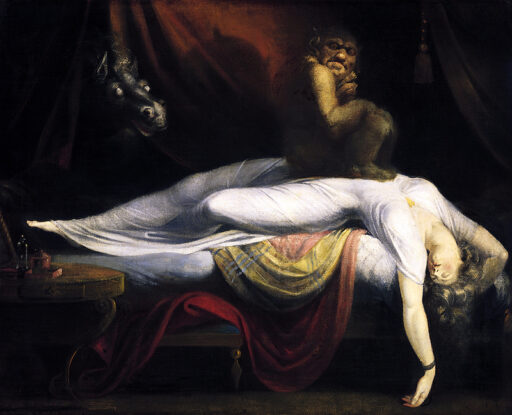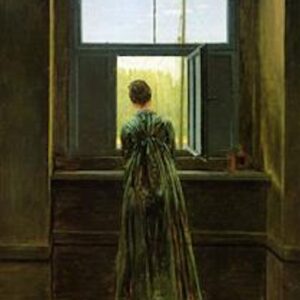I had occasion recently to watch the 1986 film Gothic. It’s a Ken Russell film and if you have ever seen a Ken Russell film, you know already that it is going to be over-the-top to say the very least. The film purportedly tells the story of the night that Mary Shelley conceived her classic novel Frankenstein. Through most of the film, the actors playing Byron (Gabriel Byrne), Percy Shelley (Julian Sands), Mary Shelley (Natasha Richardson), Claire Clairmont (Myriam Cyr) and Dr. Polidori (Timothy Spall) roam around a house and its immediate environs behaving wildly and with increasing levels of insanity. Drugs are involved. Sex. The transforming of breasts into eyes. Monsters. More drugs. Evil spirits. Byron. Lacey gowns. Leering glances. Self-inflicted stigmata. The occasional snack.
It is, all in all, a lovely flick.
I watched it because of the recent death of Julian Sands. Actually, it seems that Sands died sometime in January of this year. He was hiking alone in the San Gabriel mountains north of Los Angeles. He never came back. Then, in late June, hikers found a body in the area, which was later confirmed to be the remains of Sands. Learning about this made me sad. Sands will always have a place in my heart, mostly because of his appearance as George Emerson in A Room With A View, which is, to me, one of the most genuinely romantic films ever made.
So, in a sense, this is a tribute to Julian Sands. But I don’t want to talk about A Room With A View right now, I want to talk about Gothic. Sands seems to have had quite a bit of fun playing Shelley in the film. He rants and rages, he swoons, he strips his clothes off standing on the roof and dares the lightning to take him. In another film you might call this over-acting. But in this case, it works. And it is undoubtedly what Ken Russell wanted. Russell was the sort of director who wanted his actors to teeter at the very edge of sanity in more or less every scene.
But Gothic is not a film primarily about Percy Shelley. It is, in fact, difficult to state precisely what Gothic is about. It does not have much in the way of a plot. Much of the movie takes place in a state somewhere between nightmare and a laudanum-induced hallucination.
In fact, the word ‘nightmare’ is crucial here. The famous night during the famous Haunted Summer of 1816 gave birth to two works of literary art. One, of course, was Shelley’s Frankenstein. The other was The Vampyre, a short story by John Polidori, who was Byron’s physician and something of a piece of work himself. But Gothic brings another work of art into the film. In this case, a painting. The painting is known as The Nightmare and was created by the Swiss artist Henry Fuseli in 1781.
I have something of a minor obsession with this painting and with Fuseli in general. I’ve sat looking at the painting many times. It currently resides at the Detroit Institute of Arts just a few minutes from my home. I go to visit it frequently.
The Nightmare is a painting of a woman who is sleeping. Also, there is a horse in the room. Also, some kind of smallish demo-troll is sitting on her chest. It should be noted that there is something wrong with the horse. It has bulging eyes and is, maybe, laughing? The painting, like the film, isn’t about anything in particular. It has no specific narrative. That’s what puzzled people about the work when it was shown at the London Royal Academy exhibit of 1782. No one could figure out what it was supposed to be about.
The bafflement of viewers is understandable, since the painting isn’t about anything in specific. It portrays a nightmare. And nightmares aren’t generally all that specific. One image can be enough to make a nightmare, as Fuseli well knew. Of course, the intriguing thing about the painting, when you think about it, is that it both solves and doesn’t solve a visual problem that comes with portraying someone’s dream. Do you portray the dream, or the person having the dream? In this case, Fuseli does both.
We see the woman asleep, swooning really on her bed. And we also see, presumably, the things she is dreaming about. Or do we? Is the demon-troll in her head or actually there in the room, on her body? Is the horse part of the dream? These questions can’t be answered with any certainty. But we can probably assume that the woman is not literally having a dream in which she is asleep in a room with a hell-horse and a demon-troll.
What seems to be happening in the painting, then, is that Fuseli is simply refusing to acknowledge any meaningful difference between levels of reality, sleep and wakefulness, inside and outside, perception and imagination. Have you ever had a nightmare in which it really and genuinely felt like a heavy weight was upon your chest? It is real then, in a sense, the dream, isn’t it?
I especially love the shadow of the demon-troll on the reddish drape at the back of the painting. It is far more disturbing, in my opinion, than the actual face of the demon-troll, which is disturbing enough. But I said ‘actual face’. There is no actual face to the demon-troll, right? Because, it’s just a painting. The demon-troll never existed and the creepy shadow of the demon-troll definitely double-never-existed. And yet…
Julian Sands does not exist anymore either. Except that that’s not quite right. He is dead. But he exists. I just watched him acting, and in a sense becoming Percy Shelley during that haunted summer of 1816. I watched him in a film that, itself, suggests that our imagination, our dreams, our ravings, our madness, our wantings, that all of these things are the very stuff of reality at its most Real.
Morgan Meis has a PhD in Philosophy and is a founding member of Flux Factory, an arts collective in New York. He has written for n+1, The Believer, Harper’s Magazine, The Virginia Quarterly Review and is a contributor at The New Yorker. He won the Whiting Award for non-fiction in 2013. Morgan is also an editor at 3 Quarks Daily, and a winner of a Creative Capital | Warhol Foundation Arts Writers grant. A book of Morgan’s selected essays can be found here. His books from Slant are The Drunken Silenus. and The Fate of The Animals He can be reached at morganmeis@gmail.com.





